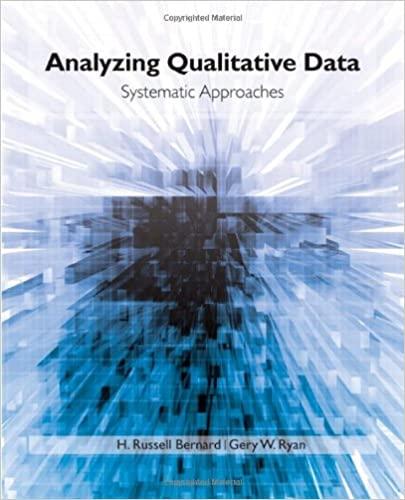Question
1) Dr Tips was interested in determining whether a waitress' message on a customer's restaurant bill (thank you, a smiley face, or no message) and
1) Dr Tips was interested in determining whether a waitress' message on a customer's restaurant bill (thank you, a smiley face, or no message) and the waitress' natural eye color (brown or green) would affect the size of her tip (measured as the mean percentage of the overall bill). A total of 120 customers were involved in the study and 20 were randomly assigned to each of the following conditions. The mean percentage tip for each condition is also provided below.
waitress eye color message type mean % tip
brown no message (NM) 12 brown smiley face (SF) 16 brown thank you (TY) 20 green no message (NM) 10
green smiley face (SF) 12
green thank you (TY) 14
1A) Place the data into the cells of the matrix and determine the row and column means (a hand- drawn matrix is fine). 1B) Draw a fully labeled line graph of the results (a hand-drawn graph is fine). 1C) List each significant effect and after each one, describe what the effect is telling us about how the variables affected tips. (For the purpose of this exercise, assume that a difference of "2" between any of the row or column means is a significant difference. Also, if the data or graph seems to indicate an interaction effect, consider it as being a significant interaction.) 1D) If any of the above effects should take precedence, indicate which effect(s). (If they are of equal importance, simply indicate so. 1E) What is the specific name given to this type of design? (as indicated on page 238 in your text) 1F) If you were to conduct a study on the effects of waitress eye color and message type on percentage tips AND on "waitress rating", how would you present these results in a line-graph format? You can either draw this or provide a short written description.
2A) Suppose you found a correlation coefficient of r = -1.05 between "time to eat a cookie" and "# of crumbs produced". How would you describe this relationship? 2B) If the correlation coefficient between "time to eat a cookie" and "# of crumbs produced" is r = -.38, what is the coefficient of determination? 2C) What is the coefficient of determination telling you about the relationship between the two variables in 2B?
3) If you suspect that "anxiety" underlies an apparent correlation between "sweating" and "heart palpitations", what statistical procedure might you use to determine if your suspicion is correct? (A description of the procedure is not necessary).
4) Generally, is it preferable to have a correlation coefficient of r = +.93 as opposed to r = -.93?
Step by Step Solution
There are 3 Steps involved in it
Step: 1

Get Instant Access to Expert-Tailored Solutions
See step-by-step solutions with expert insights and AI powered tools for academic success
Step: 2

Step: 3

Ace Your Homework with AI
Get the answers you need in no time with our AI-driven, step-by-step assistance
Get Started


